[English] 日本語
 Yorodumi
Yorodumi- PDB-1efx: STRUCTURE OF A COMPLEX BETWEEN THE HUMAN NATURAL KILLER CELL RECE... -
+ Open data
Open data
- Basic information
Basic information
| Entry | Database: PDB / ID: 1efx | ||||||
|---|---|---|---|---|---|---|---|
| Title | STRUCTURE OF A COMPLEX BETWEEN THE HUMAN NATURAL KILLER CELL RECEPTOR KIR2DL2 AND A CLASS I MHC LIGAND HLA-CW3 | ||||||
 Components Components |
| ||||||
 Keywords Keywords |  IMMUNE SYSTEM / MHC / HLA / class I / KIR / NK cell receptor / Immunoglobulin fold / receptor-MHC complex IMMUNE SYSTEM / MHC / HLA / class I / KIR / NK cell receptor / Immunoglobulin fold / receptor-MHC complex | ||||||
| Function / homology |  Function and homology information Function and homology informationSensing of DNA Double Strand Breaks / regulation of DNA recombination / entry of viral genome into host nucleus through nuclear pore complex via importin / positive regulation of viral life cycle / NS1 Mediated Effects on Host Pathways / NLS-dependent protein nuclear import complex /  host cell / nuclear import signal receptor activity / CREB1 phosphorylation through the activation of CaMKII/CaMKK/CaMKIV cascasde / host cell / nuclear import signal receptor activity / CREB1 phosphorylation through the activation of CaMKII/CaMKK/CaMKIV cascasde /  nuclear localization sequence binding ...Sensing of DNA Double Strand Breaks / regulation of DNA recombination / entry of viral genome into host nucleus through nuclear pore complex via importin / positive regulation of viral life cycle / NS1 Mediated Effects on Host Pathways / NLS-dependent protein nuclear import complex / nuclear localization sequence binding ...Sensing of DNA Double Strand Breaks / regulation of DNA recombination / entry of viral genome into host nucleus through nuclear pore complex via importin / positive regulation of viral life cycle / NS1 Mediated Effects on Host Pathways / NLS-dependent protein nuclear import complex /  host cell / nuclear import signal receptor activity / CREB1 phosphorylation through the activation of CaMKII/CaMKK/CaMKIV cascasde / host cell / nuclear import signal receptor activity / CREB1 phosphorylation through the activation of CaMKII/CaMKK/CaMKIV cascasde /  nuclear localization sequence binding / DNA metabolic process / CaMK IV-mediated phosphorylation of CREB / NLS-bearing protein import into nucleus / TAP binding / antigen processing and presentation of endogenous peptide antigen via MHC class I via ER pathway, TAP-independent / antigen processing and presentation of endogenous peptide antigen via MHC class Ib / secretory granule membrane / positive regulation of ferrous iron binding / positive regulation of transferrin receptor binding / early endosome lumen / positive regulation of receptor binding / Nef mediated downregulation of MHC class I complex cell surface expression / DAP12 interactions / negative regulation of receptor binding / lumenal side of endoplasmic reticulum membrane / Endosomal/Vacuolar pathway / Antigen Presentation: Folding, assembly and peptide loading of class I MHC / antigen processing and presentation of exogenous protein antigen via MHC class Ib, TAP-dependent / cellular response to iron(III) ion / negative regulation of forebrain neuron differentiation / ER to Golgi transport vesicle membrane / response to molecule of bacterial origin / nuclear localization sequence binding / DNA metabolic process / CaMK IV-mediated phosphorylation of CREB / NLS-bearing protein import into nucleus / TAP binding / antigen processing and presentation of endogenous peptide antigen via MHC class I via ER pathway, TAP-independent / antigen processing and presentation of endogenous peptide antigen via MHC class Ib / secretory granule membrane / positive regulation of ferrous iron binding / positive regulation of transferrin receptor binding / early endosome lumen / positive regulation of receptor binding / Nef mediated downregulation of MHC class I complex cell surface expression / DAP12 interactions / negative regulation of receptor binding / lumenal side of endoplasmic reticulum membrane / Endosomal/Vacuolar pathway / Antigen Presentation: Folding, assembly and peptide loading of class I MHC / antigen processing and presentation of exogenous protein antigen via MHC class Ib, TAP-dependent / cellular response to iron(III) ion / negative regulation of forebrain neuron differentiation / ER to Golgi transport vesicle membrane / response to molecule of bacterial origin /  regulation of erythrocyte differentiation / regulation of iron ion transport / MHC class I peptide loading complex / HFE-transferrin receptor complex / T cell mediated cytotoxicity / ISG15 antiviral mechanism / cellular response to iron ion / antigen processing and presentation of endogenous peptide antigen via MHC class I / positive regulation of T cell cytokine production / MHC class I protein complex / multicellular organismal-level iron ion homeostasis / positive regulation of T cell mediated cytotoxicity / peptide antigen assembly with MHC class II protein complex / negative regulation of neurogenesis / MHC class II protein complex / positive regulation of receptor-mediated endocytosis / protein import into nucleus / cellular response to nicotine / regulation of erythrocyte differentiation / regulation of iron ion transport / MHC class I peptide loading complex / HFE-transferrin receptor complex / T cell mediated cytotoxicity / ISG15 antiviral mechanism / cellular response to iron ion / antigen processing and presentation of endogenous peptide antigen via MHC class I / positive regulation of T cell cytokine production / MHC class I protein complex / multicellular organismal-level iron ion homeostasis / positive regulation of T cell mediated cytotoxicity / peptide antigen assembly with MHC class II protein complex / negative regulation of neurogenesis / MHC class II protein complex / positive regulation of receptor-mediated endocytosis / protein import into nucleus / cellular response to nicotine /  histone deacetylase binding / recycling endosome membrane / phagocytic vesicle membrane / specific granule lumen / peptide antigen binding / SARS-CoV-1 activates/modulates innate immune responses / positive regulation of cellular senescence / antigen processing and presentation of exogenous peptide antigen via MHC class II / Immunoregulatory interactions between a Lymphoid and a non-Lymphoid cell / Interferon gamma signaling / positive regulation of immune response / negative regulation of epithelial cell proliferation / Modulation by Mtb of host immune system / positive regulation of T cell activation / Interferon alpha/beta signaling / sensory perception of smell / negative regulation of neuron projection development / tertiary granule lumen / DAP12 signaling / MHC class II protein complex binding / late endosome membrane / T cell differentiation in thymus / positive regulation of protein binding / ER-Phagosome pathway / iron ion transport / protein refolding / early endosome membrane / protein homotetramerization / histone deacetylase binding / recycling endosome membrane / phagocytic vesicle membrane / specific granule lumen / peptide antigen binding / SARS-CoV-1 activates/modulates innate immune responses / positive regulation of cellular senescence / antigen processing and presentation of exogenous peptide antigen via MHC class II / Immunoregulatory interactions between a Lymphoid and a non-Lymphoid cell / Interferon gamma signaling / positive regulation of immune response / negative regulation of epithelial cell proliferation / Modulation by Mtb of host immune system / positive regulation of T cell activation / Interferon alpha/beta signaling / sensory perception of smell / negative regulation of neuron projection development / tertiary granule lumen / DAP12 signaling / MHC class II protein complex binding / late endosome membrane / T cell differentiation in thymus / positive regulation of protein binding / ER-Phagosome pathway / iron ion transport / protein refolding / early endosome membrane / protein homotetramerization /  nuclear membrane / Estrogen-dependent gene expression / intracellular iron ion homeostasis / amyloid fibril formation / nuclear membrane / Estrogen-dependent gene expression / intracellular iron ion homeostasis / amyloid fibril formation /  adaptive immune response / learning or memory / adaptive immune response / learning or memory /  immune response / Amyloid fiber formation / lysosomal membrane / immune response / Amyloid fiber formation / lysosomal membrane /  endoplasmic reticulum lumen / external side of plasma membrane / endoplasmic reticulum lumen / external side of plasma membrane /  Golgi membrane / Golgi membrane /  signaling receptor binding / signaling receptor binding /  focal adhesion / focal adhesion /  innate immune response / Neutrophil degranulation / endoplasmic reticulum membrane / SARS-CoV-2 activates/modulates innate and adaptive immune responses / innate immune response / Neutrophil degranulation / endoplasmic reticulum membrane / SARS-CoV-2 activates/modulates innate and adaptive immune responses /  Golgi apparatus / Golgi apparatus /  cell surface / cell surface /  endoplasmic reticulum / protein homodimerization activity endoplasmic reticulum / protein homodimerization activitySimilarity search - Function | ||||||
| Biological species |   Homo sapiens (human) Homo sapiens (human) | ||||||
| Method |  X-RAY DIFFRACTION / X-RAY DIFFRACTION /  SYNCHROTRON / SYNCHROTRON /  MOLECULAR REPLACEMENT / Resolution: 3 Å MOLECULAR REPLACEMENT / Resolution: 3 Å | ||||||
 Authors Authors | Boyington, J.C. / Motyka, S.A. / Schuck, P. / Brooks, A.G. / Sun, P.D. | ||||||
 Citation Citation |  Journal: Nature / Year: 2000 Journal: Nature / Year: 2000Title: Crystal structure of an NK cell immunoglobulin-like receptor in complex with its class I MHC ligand. Authors: Boyington, J.C. / Motyka, S.A. / Schuck, P. / Brooks, A.G. / Sun, P.D. #1:  Journal: Proc.Natl.Acad.Sci.USA / Year: 1999 Journal: Proc.Natl.Acad.Sci.USA / Year: 1999Title: Crystal Structure of the HLA-Cw3 Allotype-specific Killer Cell Inhibitory Receptor KIR2DL2 Authors: Snyder, G.A. / Brooks, A.G. / Sun, P.D. | ||||||
| History |
|
- Structure visualization
Structure visualization
| Structure viewer | Molecule:  Molmil Molmil Jmol/JSmol Jmol/JSmol |
|---|
- Downloads & links
Downloads & links
- Download
Download
| PDBx/mmCIF format |  1efx.cif.gz 1efx.cif.gz | 157.4 KB | Display |  PDBx/mmCIF format PDBx/mmCIF format |
|---|---|---|---|---|
| PDB format |  pdb1efx.ent.gz pdb1efx.ent.gz | 125.1 KB | Display |  PDB format PDB format |
| PDBx/mmJSON format |  1efx.json.gz 1efx.json.gz | Tree view |  PDBx/mmJSON format PDBx/mmJSON format | |
| Others |  Other downloads Other downloads |
-Validation report
| Arichive directory |  https://data.pdbj.org/pub/pdb/validation_reports/ef/1efx https://data.pdbj.org/pub/pdb/validation_reports/ef/1efx ftp://data.pdbj.org/pub/pdb/validation_reports/ef/1efx ftp://data.pdbj.org/pub/pdb/validation_reports/ef/1efx | HTTPS FTP |
|---|
-Related structure data
- Links
Links
- Assembly
Assembly
| Deposited unit | 
| ||||||||
|---|---|---|---|---|---|---|---|---|---|
| 1 |
| ||||||||
| Unit cell |
| ||||||||
| Details | The biological assembly is the 1:1 complex between KIR2DL2 and HLA-Cw3 observed in the asymmetric unit The biological assembly is the 1:1 complex between KIR2DL2 and HLA-Cw3 observed in the asymmetric unit |
- Components
Components
| #1: Protein | Mass: 32185.391 Da / Num. of mol.: 1 Fragment: EXTRACELLULAR ALPHA-1, ALPHA-2 AND ALPHA-3 DOMAINS Source method: isolated from a genetically manipulated source Source: (gene. exp.)   Homo sapiens (human) / Plasmid: MODIFIED PET30A / Production host: Homo sapiens (human) / Plasmid: MODIFIED PET30A / Production host:   Escherichia coli (E. coli) / References: Escherichia coli (E. coli) / References:  GenBank: 495038, UniProt: P10321*PLUS GenBank: 495038, UniProt: P10321*PLUS | ||
|---|---|---|---|
| #2: Protein |  Beta-2 microglobulin Beta-2 microglobulinMass: 11879.356 Da / Num. of mol.: 1 Source method: isolated from a genetically manipulated source Details: MATURE FORM / Source: (gene. exp.)   Homo sapiens (human) / Plasmid: MODIFIED PET30A / Production host: Homo sapiens (human) / Plasmid: MODIFIED PET30A / Production host:   Escherichia coli (E. coli) / References: UniProt: P61769 Escherichia coli (E. coli) / References: UniProt: P61769 | ||
| #3: Protein/peptide |  Mass: 868.029 Da / Num. of mol.: 1 / Fragment: RESIDUES 204-212 / Source method: obtained synthetically Details: This peptide was chemically synthesized. The sequence is naturally found in homo sapiens (human). References: UniProt: P52292 | ||
| #4: Protein | Mass: 22050.682 Da / Num. of mol.: 2 / Fragment: EXTRACELLULAR D1 AND D2 DOMAINS Source method: isolated from a genetically manipulated source Source: (gene. exp.)   Homo sapiens (human) / Plasmid: MODIFIED PET30A / Production host: Homo sapiens (human) / Plasmid: MODIFIED PET30A / Production host:   Escherichia coli (E. coli) / References: UniProt: P43627 Escherichia coli (E. coli) / References: UniProt: P43627#5: Water | ChemComp-HOH / |  Water Water |
-Experimental details
-Experiment
| Experiment | Method:  X-RAY DIFFRACTION / Number of used crystals: 1 X-RAY DIFFRACTION / Number of used crystals: 1 |
|---|
- Sample preparation
Sample preparation
| Crystal | Density Matthews: 3.64 Å3/Da / Density % sol: 65.9 % | ||||||||||||||||||||||||||||||
|---|---|---|---|---|---|---|---|---|---|---|---|---|---|---|---|---|---|---|---|---|---|---|---|---|---|---|---|---|---|---|---|
Crystal grow | Temperature: 298 K / Method: vapor diffusion, hanging drop / pH: 6.5 Details: PEG 20000, calcium chloride, sodium cacodylate, pH 6.5, VAPOR DIFFUSION, HANGING DROP, temperature 298K | ||||||||||||||||||||||||||||||
| Crystal grow | *PLUS | ||||||||||||||||||||||||||||||
| Components of the solutions | *PLUS
|
-Data collection
| Diffraction | Mean temperature: 93 K |
|---|---|
| Diffraction source | Source:  SYNCHROTRON / Site: SYNCHROTRON / Site:  NSLS NSLS  / Beamline: X9B / Wavelength: 1.0358 / Beamline: X9B / Wavelength: 1.0358 |
| Detector | Type: ADSC QUANTUM 4 / Detector: CCD / Date: Jul 25, 1999 |
| Radiation | Protocol: SINGLE WAVELENGTH / Monochromatic (M) / Laue (L): M / Scattering type: x-ray |
| Radiation wavelength | Wavelength : 1.0358 Å / Relative weight: 1 : 1.0358 Å / Relative weight: 1 |
| Reflection | Resolution: 3→30 Å / Num. all: 25779 / Num. obs: 24517 / % possible obs: 92.1 % / Observed criterion σ(I): -0.5 / Redundancy: 4.2 % / Biso Wilson estimate: 63.6 Å2 / Rmerge(I) obs: 0.073 / Net I/σ(I): 15.6 |
| Reflection shell | Resolution: 3→3.11 Å / Redundancy: 2.2 % / Rmerge(I) obs: 0.327 / Mean I/σ(I) obs: 2 / Num. unique all: 2321 / % possible all: 75.4 |
| Reflection shell | *PLUS % possible obs: 75.4 % / Num. unique obs: 1976 |
- Processing
Processing
| Software |
| |||||||||||||||||||||||||
|---|---|---|---|---|---|---|---|---|---|---|---|---|---|---|---|---|---|---|---|---|---|---|---|---|---|---|
| Refinement | Method to determine structure : :  MOLECULAR REPLACEMENT MOLECULAR REPLACEMENTStarting model: KIR2DL2 (PDB ENTRY 2DL2) and HLA-A2 (PDB ENTRY 1B0G) Resolution: 3→10 Å / Rfactor Rfree error: 0.009 / Data cutoff high absF: 2163178.14 / Data cutoff high rms absF: 2163178.14 / Data cutoff low absF: 0 / Isotropic thermal model: GROUP / Cross valid method: THROUGHOUT / σ(F): 1 / Stereochemistry target values: Engh & Huber / Details: Bulk solvent model used
| |||||||||||||||||||||||||
| Solvent computation | Solvent model: flat model / Bsol: 42.0521 Å2 / ksol: 0.28471 e/Å3 | |||||||||||||||||||||||||
| Displacement parameters | Biso mean: 63.2 Å2
| |||||||||||||||||||||||||
| Refine analyze |
| |||||||||||||||||||||||||
| Refinement step | Cycle: LAST / Resolution: 3→10 Å
| |||||||||||||||||||||||||
| Refine LS restraints |
| |||||||||||||||||||||||||
| LS refinement shell | Resolution: 3→3.18 Å / Rfactor Rfree error: 0.039 / Total num. of bins used: 6
| |||||||||||||||||||||||||
| Xplor file |
| |||||||||||||||||||||||||
| Software | *PLUS Name: CNS / Version: 0.9 / Classification: refinement | |||||||||||||||||||||||||
| Refine LS restraints | *PLUS
|
 Movie
Movie Controller
Controller


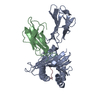


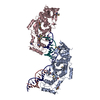

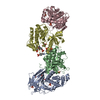
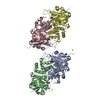

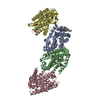

 PDBj
PDBj













